By Susan Harkins
Thank you to Connie May, Jonathan Kubesch, and Nick Koenig for sharing their technical expertise on milkweed.
The monarch butterfly, Danaus plexippus is now a candidate species for the Endangered Species Act. Habitat loss and pesticide use along their migratory routes are responsible for the decline of the monarch, but you can help by providing habitat in your own yard. You’ll need two things: nectar for the adults and milkweed (Asclepias) foliage for their caterpillars. By planting both milkweed and other native wildflowers, my yard turns into a five-star resort for not only monarchs, but other butterflies and moths, beneficial insects, and birds.
Plant a patch of native wildflowers to attract adult butterflies and milkweed for their offspring. The monarch caterpillars eat only Asclepias. Kentucky Asclepias species that easily make the move to home gardens are:
| Asclepias incarnata | Swamp Milkweed |
| Asclepias tuberoses | Butterfly Weed |
| Asclepias verticillata | Whorled Milkweed |
| Asclepias viridis | Green Milkweed |
| Asclepias syriaca | Common Milkweed |
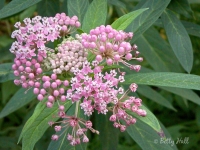
Photo by Betty Hall.
By planting both milkweed and other native wildflowers, my yard turns into a five-star resort for not only monarchs, but other butterflies and moths, beneficial insects, and birds.Despite its common name, swamp milkweed (Asclepias incarnata) will grow in most yards, though it will only reproduce reliably in wet spots. Be prepared to reseed or replant every few years to keep it going. Its deep-rose blooms are more spray-like than clusters and makes a stunning border for a larger area. It won’t spread to other areas, but it will fill in an area nicely.
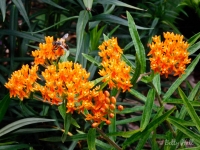
Photo by Betty Hall.
Butterfly weed (Asclepias tuberoses) has the most spectacular color—bright orange. It’s a bit bushy, grows 2 to 3 feet, and likes a sunny spot. It looks lovely planted with rue. Butterfly weed is the most dependable for returning in the same spot each year, but it doesn’t spread quickly. The leaves are thin, and I find few eggs or caterpillars on them, but the adult butterflies and other beneficial insects feed on the blooms. Butterfly weed blooms persist longer into the late summer than other milkweeds. Plant a few for a bright pop of color or create a spectacular border. Once they’re established, they’re very dependable.
Plant whorled milkweed (Asclepias verticillata) for fragrant blooms and interesting green foliage. It’s easy to establish from seedlings and like butterfly weed, whorled milkweed grows 2 to 3.
Of the five species reviewed, green milkweed (Asclepias. viridis) has proven the hardest for me to establish in a garden setting. It grows wild in every direction at my friend’s farm, so I keep trying. I encourage you to do so too because it’s so worth it! Its showy blooms are similar to common, but green, and the plants are shorter.
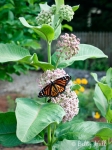
Photo by Betty Hall.
This article is about species that will work well in your home gardens. I don’t recommend that you plant common milkweed (Asclepias syriaca) in your yard. I include it to be comprehensive, but it’s beautiful in a big field far enough away that it doesn’t breech your landscaped yard.
In bloom, common milkweed is gorgeous and fragrant. Plant enough to cut some of those showy dusty-rose clustering blooms to bring inside because the scent is seductive. It prefers a sunny, well-drained spot and can reach seven feet. It spreads aggressively and dislikes intensive management. To be happy, plant it and plan to leave it be, keeping in mind that the caterpillars will completely defoliate it—another reason not to put it in your yard.
There are other species native to Kentucky, but these listed have proven most successful for me. I encourage you to explore the other species and experiment! The more you know about milkweed, the more successful your efforts will be. Common, swamp, and butterfly are readily found in nurseries in the spring. Seeds for all can be purchased online and at nurseries.
Botany and pollination
Afternoon, when the sun is out, and the air is warm is the best time to watch butterflies. Milkweed attracts the adults with color and scent. They seldom sit still for long so finding one that’s nectaring is a treat. However, an adult sitting for a bit might be stuck thanks to this flower’s unique botany. In a nutshell, the petals are slippery, and a foot or proboscis easily slips through small slits where they become covered in pollen before they can escape and fly off. Watch closely, and you may see a butterfly or insect struggle a bit. If that happens, look for the pollen—in this case, small sacs called pollinia—dangling from its legs. But pollination isn’t restricted to adult butterflies; milkweed attracts a number of beneficial insects who carry the pollen from plant to plant. I’ve never seen a milkweed in bloom without insects.
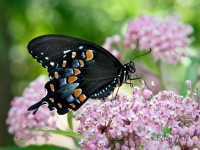
Spicebush swallowtail on swamp milkweed. Photo by Betty Hall. 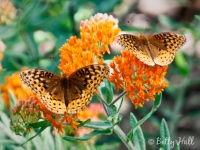
Great-spangled-fritillaries on butterfly milkweed. Photo by Betty Hall.
In Kentucky, milkweed is also host to the prolific tussock moth (Euchates egle). Many insect species, too numerous to mention, dine on milkweed. Watch for Labidomera clivicollis, the cute red and black milkweed leaf beetle. You’re certain to see Oncopeltus fasciatus, the milkweed bug. None of these are a threat to monarchs.
Propagation
Milkweed can be a bit more challenging to grow from seed than some other natives,and everyone seems to have different results. Your experiences might vary from mine, so I recommend experimenting and using one of the four following methods.
The easiest way
If you’re just starting out, take the easy route and buy milkweed plants from a reputable nursery. Don’t buy plants that have been treated with pesticides because the pesticide will kill the insects you’re inviting into your yard—ask before you purchase! Transplant nursery plants in early May and keep them well-watered for the first few weeks. Central Kentucky monarchs arrive in late summer, so your new plants will have plenty of time to grow. You might see a few adult monarchs in early spring, but the majority arrive in the late summer and early fall. Fortunately, Kentucky native milkweed blooms last though summer and provide plenty of food for that last larval generation that will pupate and migrate to Mexico.
Trays of seeds
It’s cold and rainy in central Kentucky right now; it’s the perfect time to put out trays of milkweed and other native nectar plant seeds. It’s the perfect time because milkweed and most Kentucky natives require cold moist stratification to germinate—anywhere from two weeks to three months, depending on the species.
When growing in trays or pots, give seedlings plenty of time to toughen up before planting—don’t be in a rush. I generally move seedlings from trays to pots after the first true leaves appear, and then move from pots into the ground in early summer. Once spring arrives, keep seed trays and transplants well watered for the first few weeks after planting.
Sow directly
Sow seeds directly into the ground in late fall, but don’t be disappointed if the yield is lean the first year. One or two plants will turn into several over a few seasons, and they will propagate themselves if they like the area.
How to prepare seeds
Preparing milkweed seeds isn’t difficult, but germination rates are often low, so plant a lot. Seeds require 30 days of cold, moist stratification. Stratification means to sow seeds closely together in layers of a moist planting medium. Putting trays of seeds out in winter provides the necessary stratification.
Results are unpredictable because Kentucky winters aren’t always cold for long periods of time. You can wrap seeds in a wet paper towel, put the towel in a plastic bag, and put the bag in the refrigerator for the required time. After years of testing, I have found this method to be no better than the outdoor method in central Kentucky. Plant what you love and learn to germinate more or less from the experience.
Transplant
Transplanting works with some success, but don’t dig up an adult plant. Instead, gently tug at seedlings once they’re six inches or larger. If the dirt isn’t compacted, a gentle wiggle will easily displace them. Replant in your yard or in a pot and keep well-watered for a few weeks. About 20% will return the next year. It’s free and easy.
Culture
For the most part, milkweed likes a sunny spot with well-drained soil—they have little trouble adapting to our yards. If you have a wet or shady spot, plant swamp. Milkweed does well if it likes a spot. Common is aggressive and comes up everywhere, even in turf.
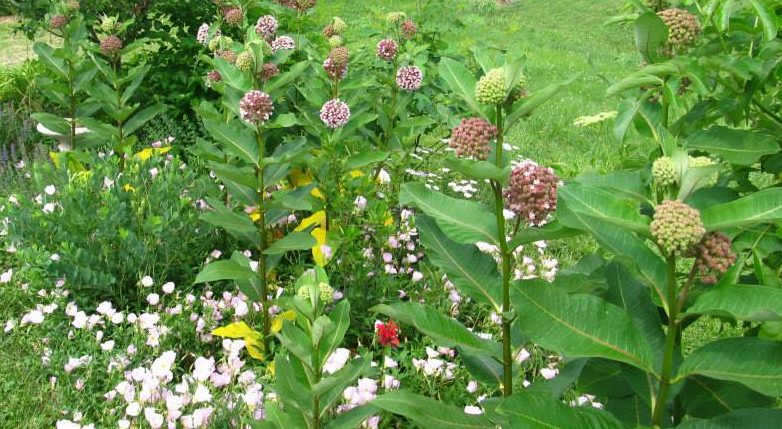
Ripen seeds burst from a crescent-shaped pod and are wind-blown in late summer and early fall. Don’t collect seeds until the pods are brown and dried up. You’ll want to keep a close eye on them at this point. Catch the pod just as the opening begins to separate. Then, grab the entire fluff ball, hold it by the tip, and run your fingernails down the compact fluff—the seeds will pop right off. If you wait until the fluff explodes, separation is difficult. Keep the seeds in a dry dark place until you plant them.
Insects damage the pods during the summer so look for small holes in the pod and the presence of live insects when collecting. An infested pod is best left on the plant as it’s unlikely to produce viable seeds.
In your garden
Milkweed tends to attract aphids, but they won’t hurt the butterflies, or their caterpillars so don’t use pesticide—you’ll kill the butterflies and caterpillars! Don’t use the garden hose to spray them off either because you might displace eggs and caterpillars. I try to catch aphids early and squash them. Be patient and let nature do what it does best. Beneficial insects, such as lacewing and ladybugs, and hummingbirds will move in and feast on the aphids.
Caterpillars have voracious appetites—eating leaves constantly before pupating. They are eating and pooping machines, and they can quickly defoliate plants. With this aesthetic concern in mind, carefully consider where to plant milkweeds. Ensure the adult butterflies still have a good line-of-sight. Cutting the plants back is a management option, but you might destroy unhatched eggs and pupae.
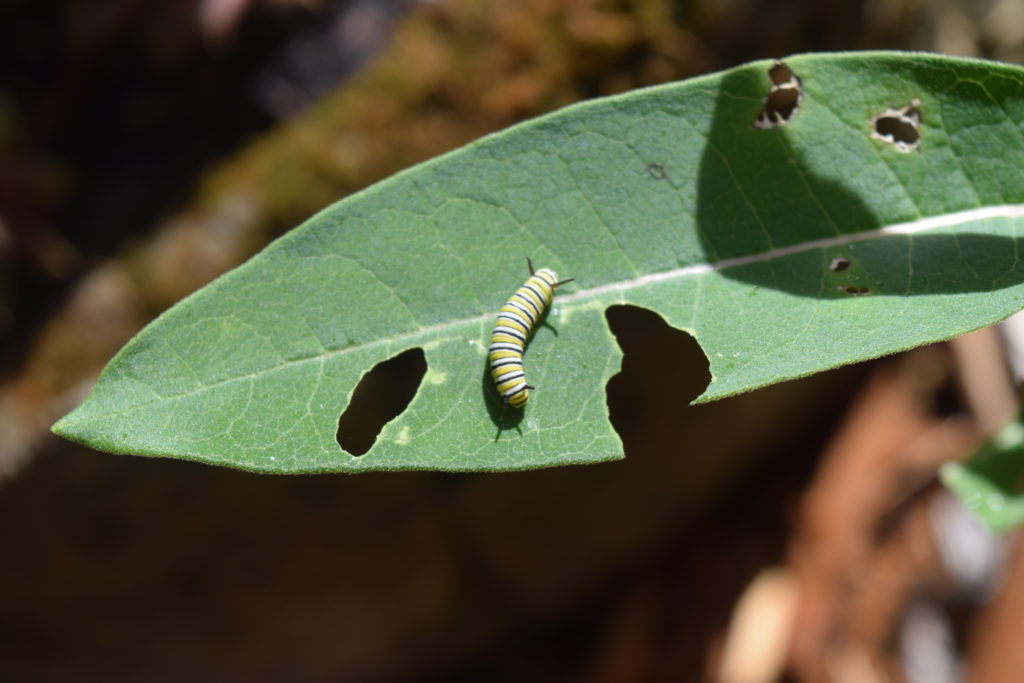
My last bit of advice comes from Dr. Adam Baker and Dr. Daniel Potter of University of Kentucky (Baker and Potter, 2019). They recommend planting milkweed along the perimeter of other native wildflowers, especially on the north and south borders because the adults migrate along that route. Monarchs flying overhead are looking for the specific shapes of the milkweed leaves, and those leaves are easier to spot when not mixed in with other species. Make a border of only milkweed to attract the most adult monarchs into your yard. They will find the other natives and perhaps stay long enough to lay their eggs on the milkweedin your yard—a monarch five-star resort where they have everything they need.
Baker and Potter (2019) found that females prefer common or swamp the most for egg-laying. Females choose the broad leaves of common milkweed for egg-laying more than other species, but swamp is also a favorite and more manageable in a smaller yard space. Consider planting multiple species for the sake of diversity.
Your yard matters
The monarch’s long migration comprises four or five generations over a year spent in route from Mexico to areas throughout the US and Canada to breed. They then migrate back to Mexico where they spend the winter. If the females find no milkweed along the way, their young perish, and migration ends. Planting milkweed and other native wildflowers will attract and keep butterflies in your yard all summer. By planting milkweed, you’ll help monarchs survive along their migratory route.
Your yard might seem insignificant in the big picture, but it matters. Right now, there’s no agency responsible for providing monarch habitat, so every yard matters. Visit these sites for more information on you can help monarchs:
US Fish & Wildlife Service Kentucky Monarch Conservation Plan
References
Configuration and Location of Small Urban Gardens Affect Colonization by Monarch Butterflies by Adam Baker and Daniel Potter, https://www.frontiersin.org/articles/10.3389/fevo.2019.00474/full.
